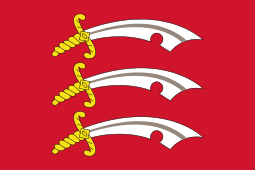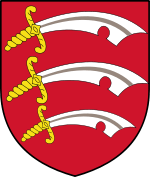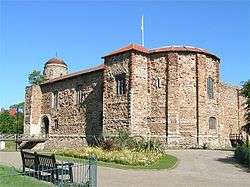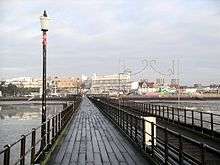Essex
| Essex | |||||
|---|---|---|---|---|---|
| County | |||||
| |||||
 Essex in England | |||||
| Coordinates: 51°45′N 0°35′E / 51.750°N 0.583°ECoordinates: 51°45′N 0°35′E / 51.750°N 0.583°E | |||||
| Sovereign state | United Kingdom | ||||
| Country | England | ||||
| Region | East | ||||
| Established | Ancient | ||||
| Ceremonial county | |||||
| Lord Lieutenant | John Petre | ||||
| High Sheriff | Nicholas Charrington | ||||
| Area | 3,670 km2 (1,420 sq mi) | ||||
| • Ranked | 11th of 48 | ||||
| Population (mid-2014 est.) | 1,729,200 | ||||
| • Ranked | 7th of 48 | ||||
| Density | 471/km2 (1,220/sq mi) | ||||
| Ethnicity |
90.8% White British 3.6% White Other 2.5% Asian 1.3% Black 1.5% Mixed 0.3% Other | ||||
| Non-metropolitan county | |||||
| County council | Essex County Council | ||||
| Executive | Conservative | ||||
| Admin HQ | Chelmsford | ||||
| Area | 3,465 km2 (1,338 sq mi) | ||||
| • Ranked | 11th of 27 | ||||
| Population | 1,396,600 | ||||
| • Ranked | 2nd of 27 | ||||
| Density | 403/km2 (1,040/sq mi) | ||||
| ISO 3166-2 | GB-ESS | ||||
| ONS code | 22 | ||||
| GSS code | E10000012 | ||||
| NUTS | UKH33 | ||||
| Website |
www | ||||
| Unitary authorities | |||||
| Councils |
Southend-on-Sea Borough Council Thurrock Council | ||||
 Districts of Essex Unitary County council area | |||||
| Districts | |||||
| Members of Parliament | List of MPs | ||||
| Police | Essex Police | ||||
| Time zone | GMT (UTC) | ||||
| • Summer (DST) | BST (UTC+1) | ||||
Essex /ˈɛsᵻks/ is a county in England, immediately north-east of London. It borders the counties of Suffolk and Cambridgeshire to the north, Hertfordshire to the west, Kent across the estuary of the River Thames to the south and London to the south-west. The county town is Chelmsford, which is the only city in the county. Essex occupies the east of the pre-England Kingdom of Essex. As well as rural areas, the county also includes the Lakeside Shopping Centre, London Stansted Airport and the new towns of Basildon and Harlow.
History
The name Essex originates in the Anglo-Saxon period of the Early Middle Ages and has its root in the Old English Ēastseaxe (i.e. the "East Saxons"), the eastern kingdom of the Saxons (cf. Middlesex and Sussex) during the Heptarchy. Originally recorded in AD 527, Essex occupied territory to the north of the River Thames, incorporating all of what later became Middlesex (which probably included Surrey) and most of what later became Hertfordshire. Its territory was later restricted to lands east of the River Lea.[1] Colchester in the north east of the county is Britain's oldest recorded town, dating back to before the Roman conquest, when it was known as Camulodunum and was sufficiently well-developed to have its own mint. In AD 824, following the Battle of Ellandun, the kingdoms of the East Saxons, the South Saxons and the Kentish were absorbed into the kingdom of the West Saxons, uniting Saxland under King Alfred's grandfather Egberht. In changes before the Norman conquest the East Saxons were subsumed into the Kingdom of England and, following the Norman conquest, Essex became a county.
During the medieval period, much of the area was designated a Royal forest, including the entire county in a period to 1204, when the area "north of the Stanetreet" was disafforested. Gradually, the areas subject to forest law diminished, but at various times included the forests of Becontree, Chelmsford, Epping, Hatfield, Ongar and Waltham.[2]
- County-wide administration
Essex County Council was formed in 1889. However County Boroughs of West Ham (1889–1965), Southend-on-Sea (1914–1974)[3] and East Ham (1915–1965) formed part of the county but were unitary authorities (not under county council control).[4] 12 boroughs and districts provide more localised services such as rubbish and recycling collections, leisure and planning, as shown in the map on the right.
- Parish-level administration – changes
A few Essex parishes have been transferred to other counties. Before 1889, small areas were transferred to Hertfordshire near Bishops Stortford and Sawbridgeworth. At the time of the main changes around the turn of the 19th/20th centuries; parts of Helions Bumpstead, Sturmer, Kedington and Ballingdon-with-Brundon were transferred to Suffolk and Great Chishill, Little Chishill and Heydon were transferred to Cambridgeshire. Later, part of Hadstock, part of Ashton and part of Chrishall were transferred to Cambridgeshire and part of Great Horkesley went to Suffolk and several other small parcels of land were transferred to all those counties.
- Boundaries
The boundary with Greater London was established in 1965 when East Ham and West Ham county boroughs and the Barking, Chingford, Dagenham, Hornchurch, Ilford, Leyton, Romford, Walthamstow and Wanstead and Woodford districts[4] were transferred to form the London boroughs of Barking and Dagenham, Havering, Newham, Redbridge and Waltham Forest. Essex became part of the East of England Government Office Region in 1994 and was statistically counted as part of that region from 1999, having previously been part of the South East England region.
- Two unitary authorities
In 1998 the boroughs of Southend-on-Sea and Thurrock were granted autonomy from the administrative county of Essex after successful requests to become unitary authorities (numbered 13 and 14 on the map to the right).[5][6]
Essex Police covers the administrative county and the two unitary authorities.[7] The county council chamber and main headquarters is at the County Hall in Chelmsford. Before 1938 the council regularly met in London near Moorgate, which with significant parts closer to that point and the dominance of railways had been more convenient than any place in the county. It currently has 75 elected councillors. Before 1965, the number of councillors reached over 100. The County Hall, made a listed building in 2007, dates largely from the mid-1930s and is decorated with fine artworks of that period, mostly the gift of the family who owned the textile firm Courtaulds.
Geography
The highest point of the county of Essex is Chrishall Common near the village of Langley, close to the Hertfordshire border, which reaches 482 feet (147 m). The ceremonial county of Essex is bounded to the south by the River Thames and its estuary (a boundary shared with Kent); to the southwest by Greater London; to the west by Hertfordshire with the boundary largely defined by the River Lea and the Stort; to the northwest by Cambridgeshire; to the north by Suffolk, a boundary mainly defined by the River Stour; and to the east by the North Sea.
The pattern of settlement in the county is diverse. The Metropolitan Green Belt has effectively prevented the further sprawl of London into the county, although it contains the new towns of Basildon and Harlow, originally developed to resettle Londoners following the destruction of London housing in World War II, since which significantly developed and expanded. Epping Forest also acts as a protected barrier to the further spread of London. Because of its proximity to London and the economic magnetism which that city exerts, many of Essex's settlements, particularly those on or within short driving distance of railway stations, function as dormitory towns or villages where London workers raise their families.
Jun2005.jpg)

Part of the south east of the county, already containing the major population centres of Basildon, Southend and Thurrock, is within the Thames Gateway and designated for further development. Parts of the south west of the county such as Buckhurst Hill and Chigwell are contiguous with Greater London neighbourhoods and so for some purposes these are included in the statistical unit the Greater London Urban Area. A small part of the south west of the county (Sewardstone), is the only settlement outside Greater London to be covered by a postcode district of the London post town (E4). To the north of the green belt, with the exception of major towns such as Colchester and Chelmsford, the county is rural, with many small towns, villages and hamlets largely built in the traditional materials of timber and brick, with clay tile or thatched roofs. This region tends to have more similarities with East Anglia than the southern and western parts of the county.
Economy
Industry is largely limited to the south of the county, with the majority of the land elsewhere being given over to agriculture. Harlow is a centre for electronics, science and pharmaceutical companies. Chelmsford has been an important location for electronics companies, such as the Marconi Company, since the industry was born and is also the location for a number of insurance and financial services organisations, and until 2015 the home of the soft drinks producer Britvic. Basildon is home to New Holland Agriculture's European headquarters and Brentwood is home to the Ford Motor Company's British HQ. Debden near Loughton is home to a production facility for British and foreign banknotes.
Other businesses in the county are dominated by mechanical engineering including but not limited to metalworking, glassmaking and plastics and the service sector. Colchester is a garrison town, and the local economy is helped by the Army's personnel living there. Basildon is the location of State Street Corporation's United Kingdom HQ International Financial Data Services, and remains heavily dependent on London for employment, due to its proximity and direct transport routes. Southend-on-Sea is home to the Adventure Island theme park and is one of the few still growing British Seaside resorts, benefiting from direct, modern rail links from Fenchurch Street railway station and Liverpool Street station (placing housing in high demand, especially for financial services commuters), which thereby maintains the town's commercial and general economy.
Parts of Eastern Essex suffer from high levels of deprivation, with one of the most highly deprived wards being the less used port of Clacton.[8] In the Indices of deprivation 2007, Jaywick was identified as the most deprived Lower Super Output Area in Southern England.[9] Unemployment was estimated at 44% and many homes were found to lack severely basic amenities. The Brooklands and Grasslands area of Jaywick were found to be the third most deprived area in England; two areas in Liverpool and Manchester rated higher. In contrast, however, West and South West Essex is one of the most affluent parts of Eastern England, forming part of the London commuter belt. Here there is a large middle class and the area is widely known for its private schools. In 2008, The Daily Telegraph found Brentwood and Ingatestone to be the 19th and 14th richest towns in the UK respectively.[10]
Politics
| General Election 2010 : Essex | ||||||||||
|---|---|---|---|---|---|---|---|---|---|---|
| Conservative | Liberal Democrats | Labour | UKIP | BNP | Others | Green | English Democrats | Christian People's Alliance | Christian Party | Turnout |
| 417,156 +57,621 |
180,391 +31,081 |
157,134 −69,179 |
35,150 +8,464 |
29,030 +21,286 |
15,651 +14,369 |
8,080 +1,447 |
4,130 +1,428 |
267 N/A |
101 N/A |
847,090 +60,741 |
| Overall Number of seats in 2010 | |||||||||
|---|---|---|---|---|---|---|---|---|---|
| Conservative | Liberal Democrats | Labour | UKIP | BNP | Others | Green | English Democrats | Christian People's Alliance | Christian Party |
| 17 | 1 | 0 | 0 | 0 | 0 | 0 | 0 | 0 | 0 |
Since 2010, the 2014 Clacton by-election led to a UKIP victory over the Conservatives giving UKIP its first seat in parliament.
Transport
The main airport in Essex is London Stansted Airport, serving destinations in Europe, North Africa and Asia.[11] The Conservative-Liberal Democrat coalition government formed in May 2010 agreed not to allow a further runway until a set time period, so curtailing the operator's ambitions for expansion. London Southend Airport, once one of Britain's busiest airports, opened a new runway extension, terminal building and railway station in March 2012.[12] The station is on the Shenfield to Southend Line, with a direct link to the capital. Southend offers scheduled flights to Ireland, the Channel Islands and multiple destinations in Europe. Essex has several smaller airfields, some of which owe their origins to military bases built during World War I or World War II, giving pleasure flights or flying lessons; examples include Clacton Airfield, Earls Colne Airfield, and Stapleford Aerodrome.
The Port of Tilbury is one of Britain's three major ports, while the port of Harwich links the county to the Hook of Holland and Esbjerg, Denmark (a service to Cuxhaven, a port on the Elbe estuary in Germany, was discontinued in December 2005). The UK's largest container terminal London Gateway at Shell Haven in Thurrock partly opened in November 2013, Final completion date is yet to be confirmed.[13] The port was opposed by the local authority and environmental and wildlife organisations.[14][15][16]
East of the Dartford Road Crossing to Dartford, Kent, across the Thames Estuary a ferry for pedestrians to Gravesend, Kent operates from Tilbury during limited daily hours, and ferries for pedestrians operate across some of Essex's rivers and estuaries during spring and summer. The M25 and M11 motorway both cross the county in the extreme south and west, enabling regular commuting to/from parts of the county with Kent, Hertfordshire and Cambridge. The A127 and A13 trunk roads are important radial routes connecting London and the M25 to the south of Essex. The A12 runs across the county from the south west to the north east and carries traffic not just within Essex but also between London and Suffolk, east Norfolk and the ports of Felixstowe and Harwich.
Rail goods have several ports and dedicated lines.[17]
Much of Essex lies within the London commuter belt. Abellio Greater Anglia (run by Abellio, the international arm of Nederlandse Spoorwegen) is the key railway operator in the county, providing commuter services into London Liverpool Street and regional services throughout the East of England. The main railway routes in Essex include:
- Three lines from the City of London to Southend-on-Sea: two operated by c2c from Fenchurch Street railway station (one route via Tilbury) and by Abellio Greater Anglia from Liverpool Street station;
- The Great Eastern Main Line from Liverpool Street to Suffolk and Norfolk as well as the international port at Harwich International;
- The West Anglia Main Line from Liverpool Street to London Stansted Airport and onward to Cambridgeshire.
The southernmost part of Epping Forest district is served by the London Underground Central line. The routes operated by Abellio Greater Anglia were operated by National Express East Anglia and were previously branded as 'One'. Branch lines include:
- The Sunshine Coast Line linking Colchester to the seaside resorts of Clacton-on-Sea and Walton-on-the-Naze via the picturesque towns of Wivenhoe and Great Bentley.
- The Crouch Valley Line linking Wickford to Southminster via the riverside communities including South Woodham Ferrers and Burnham-on-Crouch.[18]
South Essex Rapid Transit is a proposed public transport scheme which would provide a fast, reliable public transport service in and between Thurrock, Basildon and Southend.[19]
Education
Education in Essex is substantially provided by three authorities being Essex County Council and the two unitary authorities, Southend-on-Sea and Thurrock. In all there are some 90 state secondary schools provided by these authorities, the majority of which are comprehensive, although one in Uttlesford, two in Chelmsford, two in Colchester and four in Southend-on-Sea are selective grammar schools. There are also various independent schools particularly, as mentioned above, in rural parts and the west of the county.[20][21]
The University of Essex, which was established in 1963, is located just outside Colchester, with two further campuses in Loughton and Southend-on-Sea. University Campus Suffolk, with a main campus in Ipswich and five centres in the counties of Norfolk and Suffolk, is a joint venture between University of Essex and East Anglia polytechnic.
Culture
The county's coat of arms comprises three Saxon seax knives (although looking rather more like scimitars) arranged on a red background (Gules three Seaxes fessewise in pale Argent pomels and hilts Or points to the sinister and cutting edges upwards); the three-seax device is also used as the official logo of Essex County Council having been granted as such in 1932.[22] The emblem was attributed to Anglo-Saxon Essex in Early Modern historiography. The earliest reference the arms of the East Saxon kings was by Richard Verstegan, the author of A Restitution of Decayed Intelligence (Antwerp, 1605), claiming that "Erkenwyne king of the East-Saxons did beare for his armes, three [seaxes] argent, in a field gules". There is no earlier evidence substantiating Verstegan's claim, which is an anachronism for the Anglo-Saxon period seeing that heraldry only evolved in the 12th century, well after the Norman conquest. John Speed in his Historie of Great Britaine (1611) follows Verstegan in his descriptions of the arms of Erkenwyne, but he qualifies the statement by adding "as some or our heralds have emblazed".[22]
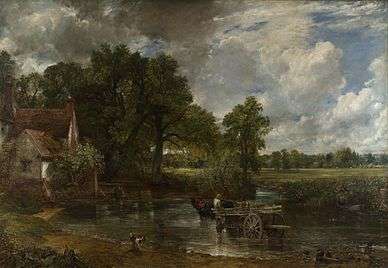
Essex is also home to the Dunmow Flitch Trials, a traditional ceremony that takes place every four years and consists of a test of a married couple's devotion to one another. A common claim of the origin of the Dunmow Flitch dates back to 1104 and the Augustinian priory of Little Dunmow, founded by Lady Juga Baynard. Lord of the Manor Reginald Fitzwalter and his wife dressed themselves as humble folk and begged blessing of the Prior a year and a day after marriage. The prior, impressed by their devotion bestowed upon them a flitch of bacon. Upon revealing his true identity, Fitzwalter gave his land to the priory on the condition a flitch should be awarded to any couple who could claim they were similarly devoted. By the 14th century, the Dunmow Flitch Trials appear to have achieved a significant reputation outside the local area. The author William Langland, who lived on the Welsh borders, mentions it in his 1362 book The Vision of Piers Plowman in a manner that implies general knowledge of the custom among his readers.[23]
Essex has become associated with the derogatory stereotype, 'Essex girl' and the political stereotype 'Essex man'. The association has been amplified in popular culture through the reality television series 'TOWIE' (The Only Way Is Essex), which has attracted criticism for its stereotyping.
The Essex dialect, an accent related to the Suffolk dialect, was formerly prevalent in the county but is now mostly replaced by Estuary English.
Sport
Essex is home to two English Football League teams in Southend United and Colchester United, with both teams playing in the league as high as the Championship during their history. As of 2016-17 Southend United are in League One, while Colchester United are in League Two. Braintree Town are the next highest placed football team playing in the National League, while the highest domestic trophy for non league teams, the FA Trophy has been won on four occasions by Essex teams with the last coming in 2005-06 season with Grays Athletic.
Essex County Cricket Club became a First Class County in 1894. The county has won 6 County Championship league titles which occurred during the dominant period between 1979 and 1992. The team won promotion to Division One by winning the 2016 Division Two title.
The County is also home to the Lakeside Hammers speedway team (formerly Arena Essex Hammers), the Chelmsford Chieftains Ice Hockey team and the Essex Leopards basketball team. It has previously been home to the Essex Eels Rugby League team, as well as the Essex Pirates basketball team.
During the 2012 London Olympics, Hadleigh laid host to the Mountain Bike races.
Many world renown sport stars have come from or trained in Essex. These have included swimmer Mark Foster; cricket stars Trevor Bailey and Graham Gooch; footballers Peter Taylor, James Tomkins, Justin Edinburgh, Nigel Spink; tennis stars John Lloyd and David Lloyd; Olympic Gold winning gymnast Max Whitlock; Olympic sailing champion Saskia Clark; World Champion snooker stars Stuart Bingham & Steve Davis; World champion boxers Terry Marsh & Frank Bruno; London Marathon winner Eamonn Martin; International rugby players Malcolm O'Kelly and Stuart Barnes; Formula 1 and Sports car drivers Johnny Herbert & Perry McCarthy.
Landmarks
Over 14,000 buildings have listed status in the county, and around 1000 of those are recognised as of Grade I or II* importance.[24] The buildings range from the 7th century Saxon church of St Peter-on-the-Wall, to the Royal Corinthian Yacht Club which was the United Kingdom's entry in the "International Exhibition of Modern Architecture" held at the Museum of Modern Art in New York City in 1932. Southend Pier is in the Guinness Book of Records as the longest pleasure pier in the world.
-
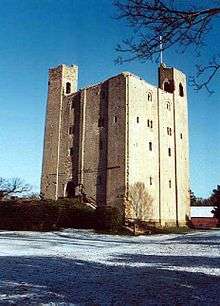
The Grade I listed Hedingham Castle
with the best preserved Norman keep in the UK -
Thaxted Guildhall
dating from around 1450 -
The 17th century Audley End House
Saffron Walden -
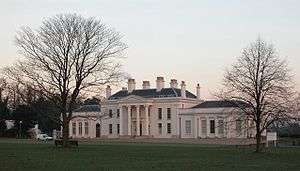
Hylands House,
south of Writtle
and southwest of Chelmsford
Places of interest
See full article, List of places of interest in Essex.
| Key | |
| | Abbey/Priory/Cathedral |
| | Accessible open space |
| | Amusement/Theme Park |
| | Castle |
| | Country Park |
| | English Heritage |
| | Forestry Commission |
| | Heritage railway |
| | Historic House |
| | Museum (free/not free) |
| | National Trust |
| | Theatre |
| | Zoo |
- Abberton Reservoir
- Ashdon (The site of the ancient Bartlow Hills and also a claimant to the location of the Battle of Ashingdon)
- Ashingdon (The site of the Battle of Ashingdon in 1016), near Southend, with its isolated St Andrews Church and site of England's earliest aerodrome at South Fambridge
- Audley End House and Gardens, Saffron Walden

- Brentwood Cathedral

- Clacton-on-Sea
- Chelmsford Cathedral

- Colchester Castle

.svg.png) [25]
[25] - Colchester Zoo

- Colne Valley Railway

- Cressing Temple
- East Anglian Railway Museum
.svg.png)
- Epping Forest
- Epping Ongar Railway

- Finchingfield (Considered the most beautiful village in England and home of the author Dodie Smith)
- Frinton-on-Sea
- Great Bentley
 , which has the largest village green in England
, which has the largest village green in England - Hadleigh Castle
- Harlow New Town
- Hedingham Castle, between Stansted and Colchester, to the north of Braintree

- Ingatestone Hall, Ingatestone, between Brentwood and Chelmsford
- Kelvedon Hatch Secret Nuclear Bunker
- Lakeside Shopping Centre
- Loughton, by Epping Forest and having a London Underground Central line tube station
- Maldon historic market town, close to Chelmsford and the North Sea, and site of the Battle of Maldon
- Mangapps Railway Museum

.svg.png) (Burnham-on-Crouch)
(Burnham-on-Crouch) - Marsh Farm Country Park (South Woodham Ferrers)
- Mersea Island, birdwatching and rambling resort with one settlement, West Mersea
- Mistley Towers, Manningtree, between Colchester and Ipswich, near Alton Water.
- Mountfitchet Castle
 , Stansted
, Stansted - North Weald Airfield
- Orsett Hall Hotel, Prince Charles Avenue, Orsett near Chadwell St Mary
- St Peter-on-the-Wall

- Saffron Walden
.svg.png)


- Southend Pier
- Thames Estuary

- Tilbury Fort

- Thaxted, south of Saffron Walden
- University of Essex (Wivenhoe Park, Colchester and Loughton)
- Waltham Abbey

Notable persons
- See Category:People from Essex.
Sister counties and regions
-
 Jiangsu, China
Jiangsu, China -
 Picardy, France
Picardy, France -
 Thuringia, Germany
Thuringia, Germany -
 Henrico County, Virginia, United States
Henrico County, Virginia, United States -
 Accra, Ghana
Accra, Ghana
See also
- The Earl of Essex
- List of Lord Lieutenants of Essex
- Healthcare in Essex
- List of High Sheriffs of Essex
- Custos Rotulorum of Essex – Keepers of the Rolls
- Historical list of MPs of Essex constituency
- Q Camp: WWII camp in Essex
- List of civil parishes in England
- The Only Way Is Essex
- List of Sites of Special Scientific Interest in Essex
- Essex Police
- Essex Police and Crime Commissioner
Notes and references
- Notes
- ↑ Vision of Britain – Essex ancient county boundaries map
- ↑ Raymond Grant (1991). The royal forests of England. Wolfeboro Falls, NH: Alan Sutton. ISBN 0-86299-781-X. 086299781X. see table, p224 for Essex Stanestreet and p221-229 for details of each forest
- ↑ Vision of Britain – Southend-on-Sea MB/CB
- 1 2 Vision of Britain – Essex admin county (historic map)
- ↑ Essex County Council – District or Borough Councils
- ↑ OPSI – The Essex (Boroughs of Colchester, Southend-on-Sea and Thurrock and District of Tendring) (Structural, Boundary and Electoral Changes) Order 1996
- ↑ OPSI – The Essex (Police Area and Authority) Order 1997
- ↑ "Did you know deprivation in Chelmsford Diocese". Archived from the original on 8 March 2012. Retrieved 4 February 2016.
- ↑ "Jackwich: Village 'third most deprived area in UK'". Archived from the original on 9 October 2011. Retrieved 4 February 2016.
- ↑ "Britain's richest towns: 20 – 11". The Daily Telegraph. London. 18 April 2008. Archived from the original on 3 February 2014.
- ↑ Cheap flights from London Stansted to Sharm El Sheikh. easyJet.com (17 February 2013). Retrieved on 17 July 2013.
- ↑ Topham, Gwyn (5 March 2012). "London Southend airport: flying under the radar (and to the left of the pier)". The Guardian. London. Retrieved 5 March 2012.
- ↑ "London Gateway : Home". www.londongateway.com. Retrieved 2016-06-18.
- ↑ Portswatch: Current Port Proposals: London Gateway (Shell Haven). Retrieved 15 April 2009.
- ↑ Thurrock Council. (26 February 2003). Shell Haven public inquiry opens. Retrieved 15 April 2009.
- ↑ Dredging News Online. (18 May 2008). Harbour Development, Shell Haven, UK. Retrieved 15 April 2009.
- ↑ "OS Maps - online and App mapping system | Ordnance Survey Shop". getamap.ordnancesurvey.co.uk. Retrieved 2016-06-18.
- ↑ "National Rail Enquiries - Official source for UK train times and timetables". www.nationalrail.co.uk. Retrieved 2016-06-18.
- ↑ "FAQs". www.sert.org.uk. Archived from the original on 2 September 2009. Retrieved 2016-06-18.
- ↑ Essex County Council. (2006). Secondary School Information. Retrieved 15 April 2009.
- ↑ independent schools Directory. (2009). Independent Schools in Essex. Retrieved 15 April 2009.
- 1 2 Robert Young. (2009). Civic Heraldry of England and Wales. Essex. Retrieved 16 April 2009.
- ↑ "Dunmow Flitch Trials - History - Background". www.dunmowflitchtrials.co.uk. Retrieved 2016-06-18.
- ↑ Bettley, James. (2008). Essex Explored: Essex Architecture. Essex County Council. Retrieved 15 April 2009.
- ↑ "Colchester Castle Museum-Index". Colchestermuseums.org.uk. Retrieved 23 April 2010.
[23] Essex Coast Walk. Peter Caton 2009. ISBN 978-1848761162
External links
| Wikimedia Commons has media related to Essex. |
| Wikivoyage has a travel guide for Essex (England). |
- Essex at DMOZ
- Visit Essex
- Essex County Council
- Essex Weather Centre Weather forecasts part-funded by Essex County Council
- Seax – Essex Archives Online
- Images of Essex at the English Heritage Archive
 |
Cambridgeshire | Cambridgeshire / Suffolk | Suffolk |  |
| Hertfordshire | |
North Sea | ||
| ||||
| | ||||
| Greater London | Kent | Thames Estuary |
